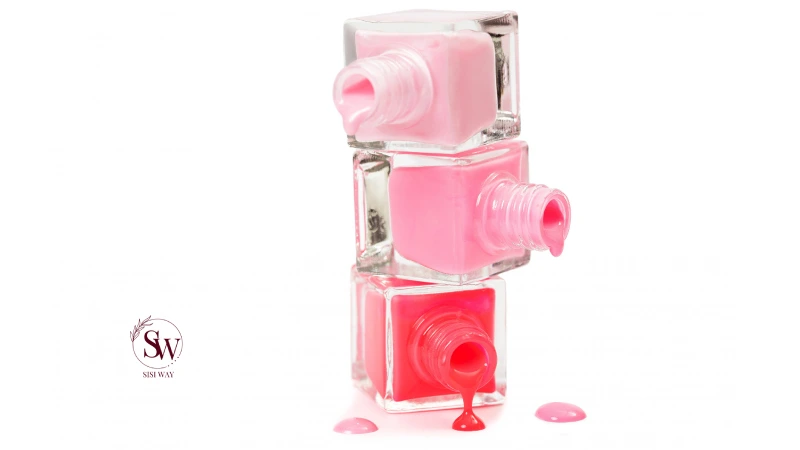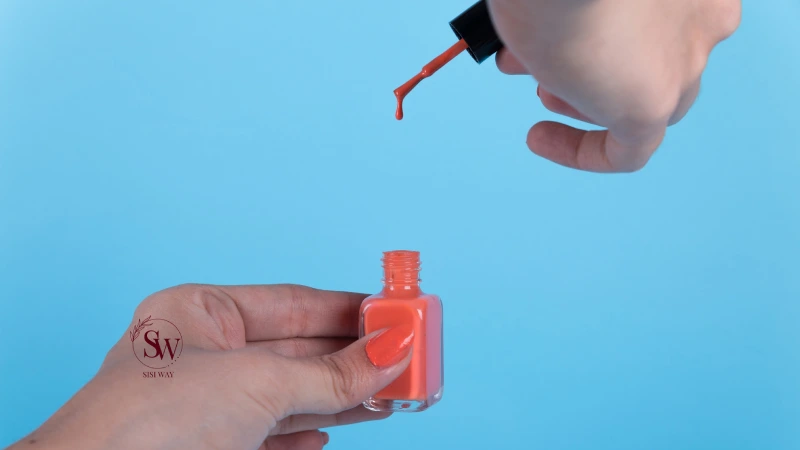
Will Nail Polish Cause Cancer?
Nail polish is a popular cosmetic product used by millions of people around the world. It adds color and flair to our nails, allowing us to express our personal style and creativity. However, concerns have been raised about whether nail polish can potentially cause cancer. In this article of sisiway, we will delve into the topic and explore the current scientific understanding to determine if there is a link between nail polish and cancer.

Understanding Nail Polish Composition
To assess the potential link between nail polish and cancer, it is crucial to understand the composition of nail polish. Nail polish formulations typically consist of solvents, resins, plasticizers, pigments, and film-forming agents. These ingredients work together to create the desired color, texture, and durability of the nail polish. Some formulations may also contain additional chemicals, such as formaldehyde, toluene, and dibutyl phthalate (DBP), which have raised concerns regarding their potential health effects. However, it is important to note that the levels of these chemicals in most commercial nail polishes are generally within safe limits established by regulatory authorities. Moreover, many reputable nail polish brands now offer alternative formulations that are free from potentially harmful substances, addressing the concerns associated with certain ingredients.
Read more: How Do I Strengthen My Nails?

Nail Polish and Cancer
The question of whether nail polish can cause cancer has been the subject of scientific investigation. While some of the chemicals found in nail polish formulations, such as formaldehyde and toluene, have been classified as carcinogens, the levels present in consumer nail polishes are generally considered to be low and unlikely to pose significant risks when used as directed. The occasional and proper use of nail polish is unlikely to result in a substantial exposure to these chemicals. Furthermore, regulatory agencies have established safety standards and restrictions on nail polish ingredients to protect consumers. However, individuals with specific concerns or preexisting health conditions should consult with healthcare professionals for personalized advice. It is also important to follow safe practices when using nail polish, such as applying it in a well-ventilated area and choosing formulations that are labeled as “3-free” or “5-free” to minimize potential exposure to harmful substances.

Examining the Concerns
Examining the concerns surrounding nail polish and its potential health risks is crucial for informed decision making. By evaluating scientific studies, regulatory standards, and industry practices, individuals can gain a better understanding of the actual risks and take appropriate measures to minimize any potential harm. The main concerning and debatable factors regarding the question of “Can Nail Polish Cause Cancer” include the following ingredients:
-
Formaldehyde:
Formaldehyde is a chemical that has been associated with potential health risks, including its potential as a carcinogen. It is used in various industries, including the production of nail polish. Concerns have been raised about the presence of formaldehyde in nail polish and its potential link to cancer. Formaldehyde can be released from certain nail polish formulations during application and drying. However, it is important to note that the levels of formaldehyde in most commercial nail polishes are within safe limits established by regulatory authorities. Moreover, many nail polish brands have responded to these concerns by offering formaldehyde-free formulations, reducing the potential risk associated with this particular chemical. While the occasional and proper use of nail polish is unlikely to cause cancer, individuals with specific concerns or preexisting health conditions should seek advice from healthcare professionals.

-
Toluene:
Toluene is a chemical commonly used as a solvent in nail polish formulations. It has been the subject of concern regarding its potential health effects, including its association with cancer. Prolonged and excessive exposure to toluene in occupational settings has been linked to health issues. However, it is important to note that the levels of toluene in consumer nail polishes are generally low and unlikely to pose significant risks when used as directed. Regulatory agencies, such as the U.S. Food and Drug Administration (FDA) and the European Union’s Cosmetic Products Regulation, have established safety standards and restrictions on the use of toluene in nail polish to protect consumers. Moreover, many reputable nail polish brands have taken steps to minimize or eliminate the use of toluene in their formulations, offering safer alternatives for consumers.
-
Dibutyl Phthalate (DBP):
Dibutyl Phthalate (DBP) is a plasticizer that was commonly used in nail polish to increase its flexibility and durability. However, concerns have been raised about the potential health risks associated with DBP, including its potential link to cancer. DBP has been restricted or banned in many countries due to its potential to disrupt hormone function and potential reproductive toxicity. As a result, most reputable nail polish brands have removed DBP from their formulations, offering safer alternatives for consumers. The regulatory measures and industry response to the concerns surrounding DBP have significantly reduced the potential risk of exposure to this chemical through nail polish use.
Can Smelling Nail Polish Cause Cancer?
The occasional exposure to the fumes of nail polish is unlikely to cause cancer. However, nail polish fumes may contain small amounts of potentially harmful chemicals, such as formaldehyde, toluene, and DBP. Prolonged and excessive inhalation of these fumes, especially in occupational settings with high levels of exposure, has been associated with health risks. To minimize any potential risks, it is advisable to use nail polish in a well-ventilated area and avoid prolonged or excessive exposure to the fumes.

Scientific Evidence and Regulation:
Several scientific studies have explored the potential health effects of nail polish ingredients. The current body of evidence suggests that the occasional use of nail polish, following the recommended application guidelines, poses minimal risks to human health. Regulatory agencies, such as the U.S. Food and Drug Administration (FDA) and the European Union’s Cosmetic Products Regulation, have established safety standards and restrictions on nail polish ingredients to protect consumers.
Safe Practices and Precautions:
While the risks associated with nail polish are generally low, it is essential to follow safe practices and take precautions when using these products. Consider the following recommendations:
-
Adequate Ventilation:
Adequate ventilation is an essential factor to consider when using nail polish to minimize potential risks associated with its ingredients. Nail polish contains various chemicals, some of which may emit fumes that can be inhaled during application. To minimize exposure to these fumes, it is important to apply nail polish in a well-ventilated area. This can be achieved by opening windows or using exhaust fans to promote air circulation and reduce the concentration of any potentially harmful substances in the air. Adequate ventilation helps to mitigate the inhalation of fumes and reduces the potential health risks associated with nail polish use.
-
Limit Exposure:
Limiting exposure and practicing safe habits when using nail polish can help minimize potential risks associated with its ingredients. While the occasional use of nail polish is generally considered safe, it is important to avoid prolonged and excessive exposure to minimize any potential health risks. Taking breaks between applications allows the nails to breathe and reduces the cumulative exposure to nail polish chemicals. This practice is particularly important for individuals who frequently apply nail polish or work in professions that involve regular exposure to nail polish.
-
Choose Safer Formulations:
Choosing safer formulations and practicing safe habits when using nail polish can help reduce potential risks associated with its ingredients. Many reputable nail polish brands now offer alternative formulations that are free from potentially harmful substances, such as formaldehyde, toluene, and DBP. These formulations are often labeled as “3-free” or “5-free” and provide a safer option for consumers concerned about the potential health effects of these chemicals. By choosing nail polishes with safer formulations, individuals can enjoy using nail polish while minimizing their exposure to potentially harmful substances. You can choose the best nail polish formulation for yourself from among the Top 10 Nail Polish Brands to beautify your nails in the safest way possible.

-
Practice Good Nail Hygiene
Practicing good nail hygiene and safe habits when using nail polish is essential for maintaining overall nail health and minimizing potential risks associated with its use. Good nail hygiene includes keeping the nails clean, properly trimmed, and moisturized. This helps prevent the accumulation of dirt, bacteria, and other potential contaminants that can affect nail health. Regularly removing and reapplying nail polish also allows the nails to breathe and prevents the buildup of residue or potential harmful chemicals.

FAQ
- Can nail polish cause cancer?
While the occasional use of nail polish is unlikely to cause cancer, some chemicals found in nail polish formulations, such as formaldehyde, toluene, and DBP, have been associated with potential health risks. However, the levels of these chemicals in most commercial nail polishes are generally within safe limits established by regulatory authorities. Choosing nail polishes labeled as “3-free” or “5-free” and practicing safe habits, such as applying nail polish in a well-ventilated area, can help minimize potential risks.
- Is formaldehyde in nail polish linked to cancer?
Formaldehyde is a chemical that has been classified as a carcinogen. However, the levels of formaldehyde in most consumer nail polishes are generally low and unlikely to pose significant risks when used as directed. Regulatory agencies have established safety standards and restrictions on the use of formaldehyde in nail polish to protect consumers. Additionally, many nail polish brands now offer formaldehyde-free formulations, reducing the potential risk associated with this particular chemical.
- Are there safer alternatives to traditional nail polish?
Yes, there are safer alternatives to traditional nail polishes. Many reputable nail polish brands now offer formulations that are free from potentially harmful substances, such as formaldehyde, toluene, and DBP. These alternatives are often labeled as “3-free” or “5-free” and provide a safer option for individuals concerned about the potential health effects of these chemicals. Choosing these safer alternatives and practicing safe habits when using nail polish can help minimize potential risks and promote nail health.
Conclusion:
Based on the current scientific understanding, the occasional and proper use of nail polish is unlikely to cause cancer or significant health risks. However, it is essential to be aware of the ingredients in nail polish formulations, choose reputable brands, and follow safe application practices. If you have specific concerns or preexisting health conditions, it is advisable to consult with a healthcare professional. With proper knowledge and precautions, you can enjoy the benefits of nail polish while prioritizing your well-being.



